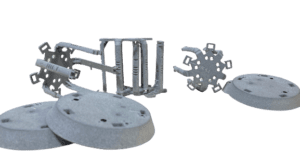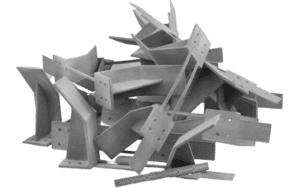What is Bridge Manufacturing?
Manufacturing is not a cut-and-dry process. It encompasses everything from research and product development to production and replacement parts for multiple industries as diverse as consumer goods, automotive, healthcare, and, even, renewable energy. The objective is to develop a product not only fit for purpose within the market, but also designed so that it can be manufactured as easily and cost effectively as possible. To transition from development to mass production, many companies are turning to bridge manufacturing.
As the name suggests, bridge manufacturing or bridge tooling is a valuable step in the product development process that “bridges” the gap between prototypes and mass production. 3D printing or additive manufacturing (AM) technology takes bridge tooling to the next level with flexible design iteration and short-run production.
Flexible Design & Manufacturing

Bridge Manufacturing: Lubrizol Corrosion Testing Tools
Conventional manufacturing methods, like CNC machining or injection molding, require time and money for cutting patterns, molds and other tooling components. While the cost and length of traditional production processes limit the redesign of a given part, 3D printing’s freedom from manufacturing constraints allows for quick and cost-effective design iteration. Additive manufacturing allows companies to perfect their designs before committing the time and capital for production tooling, minimizing risks associated with launching a new product and providing the production flexibility to meet uncertain market demands. With no tooling costs and no minimum volumes, AM shortens lead times from months to weeks, or even days. All that is needed to start production is a
3D CAD model.

Bridge Manufacturing: Vestas Sustainable Energy Solutions
Short-run production of final prototypes can be used for market testing and validation. Any shortcomings in the design can be identified and addressed before production release, saving additional time and costs down the line. While some companies may choose to invest in traditional manufacturing methods for prototyping and market testing, others often have limited resources or need additional market validation first. This is when bridge manufacturing with additive technology can help businesses scale from prototypes to production. Low-volume production of initial product can even be used to generate capital to fund mass production
Additive manufacturing also provides the ability to bridge the supply gap. Capable of catering to volumes which otherwise would be costly and time consuming via production tooling, 3D printing enables companies to service immediate demand with small-batch and flexible manufacturing until production tooling is ready to run.
In either case, additive bridge tooling makes market testing and low-volume manufacturing faster and more cost-effective.
BENEFITS OF ADDITIVE BRIDGE MANUFACTURING
-
- Rapid design iteration
- Minimized risks at launch
- Shorter lead times
- No production tooling & minimum volumes
- Production flexibility
- Local manufacturing
Is Bridge Manufacturing Right for You?
3D printing and bridge manufacturing have made prototyping, market testing, and short-run production more accessible to all types of companies. Additive bridge manufacturing offers unprecedented agility, unparalleled speed and iterative potential- transforming product design and making production more efficient. Utilizing 3D printing from development to production provides the design and manufacturing flexibility necessary to perfect products and shortens the product development cycle.
Whether you are looking for bridge manufacturing, on-demand production, or functional prototypes, Avid Product Development is here to partner with you toward the best solution for your additive manufacturing needs. Contact us to learn how we can help you achieve scalable additive manufacturing results.
